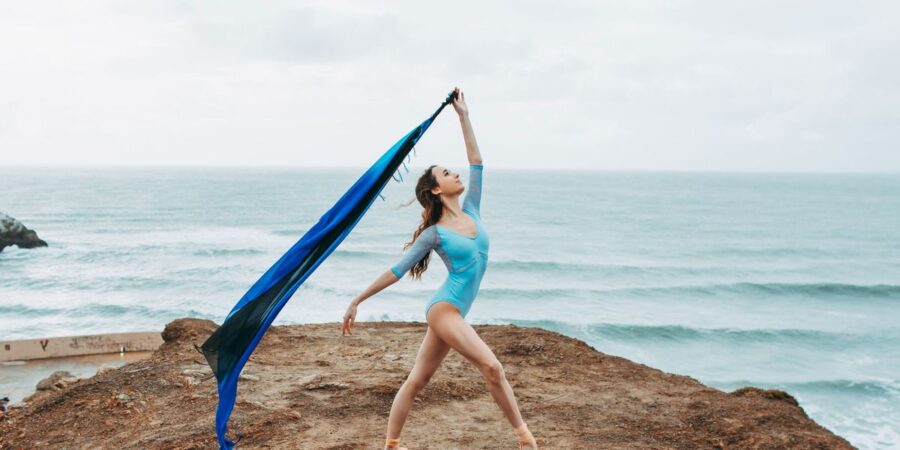The performing arts have traditionally been confined to the stage, but the digital age has introduced a new platform for artistic expression: the handheld screen. This shift raises a crucial question: can the centuries-old discipline of classical dance, rooted in tradition and physical presence, thrive in the ephemeral world of social media? Alina Taratorin, a prodigy of classical ballet and a Harvard-educated polymath, is a transitional figure who embodies the synthesis of these two worlds. Her career provides a compelling case study of a new type of artist-creator who bridges the demanding rigor of elite physical training with the intimate, democratized platforms of digital culture.
Foundations: From Classical Rigor to Contemporary Expression
Alina Taratorin’s artistic identity is built on a foundation of discipline and rigorous training. She began her dance journey at age six at the Bayer Ballet in California, where she studied the Vaganova method, a system known for its strict adherence to form and technique. This intensive education prepared her for significant pre-professional achievements. She is a three-time World Ballet Competition winner, earning gold medals in 2014, 2015, and 2016, which placed her among the world’s elite young dancers. Her participation in the 2020 Prix de Lausanne, a competition often called the “Olympics” of dance, further cemented her status as a top-tier ballet artist.
In stark contrast to the conventional path of many pre-professional dancers who are homeschooled, Taratorin made the “arduous” choice to balance public high school with her dance career. This decision, driven by her deep academic inclination, culminated in her Early Action acceptance to Harvard University. This fusion of virtuosic physical talent and intellectual rigor challenges the historical stereotype of the artist as a singular specialist. Her artistic identity is also enriched by her early training as a pianist, which included performances at Carnegie Hall. Her director, Inna Bayer, has noted that this background gives her a unique and exceptional musicality that allows her to “feel music” beyond mere technical execution.
The Digital Stage: Curation and Performance
The current dance landscape is increasingly shaped by the digital sphere, which Taratorin navigates with a distinct aesthetic. Her personal YouTube and Instagram channels are not just promotional outlets but primary artistic platforms where she creates and shares her work. Her content, characterized by short, intimate videos often focused on improvisation, is a deliberate departure from the polished grandeur of her classical training. This contrasts with her formal performances, such as her classical variation from
Paquita at the Prix de Lausanne.
Taratorin’s digital works are frequently tagged with introspective phrases like “movement therapy” and “inner peace”. This practice places her within the lineage of performance art, which uses the body as a medium to explore internal states and break down boundaries between art and life. Her work creates a new kind of intimacy in digital performance, moving from a distant theatrical frame to a direct, personal connection with viewers. The choreography is created
for the screen, using close-ups and an aesthetic of raw, unfiltered emotion often captured in a low-fi, user-generated style. This approach transforms the passive viewing experience into one of personal connection and resonance.
This form of digital expression also presents a paradox: the fusion of ephemerality with digital permanence. While her improvisations are by nature fleeting, publishing them online transforms them into infinitely reproducible and enduring artifacts. For example, an improvised video titled “move the soul” has garnered hundreds of thousands of views, turning a fleeting act into a lasting record. This challenges the idea that mechanical reproduction diminishes an artwork’s “aura”. Instead, these digital creations forge a new kind of value derived not from the rarity of a live event but from the perceived intimacy and authenticity of the artist’s personal creative act.
Critical Perspectives: The Artist, The Market, and Authenticity
Taratorin’s career challenges the prevailing paradigms of the dance world and the art market. Her journey from the competitive ballet stage to the expressive space of digital performance is not just a stylistic evolution but a philosophical one. She has been open about her struggles with the competitive nature of ballet, describing how she had to learn to “control [her] own mind” to perform at her peak. She also points out the “counter-productive nature of comparison” and the fact that “there is no perfect dancer out there”. This stance is a powerful critique of the classical ballet paradigm, which often defines success through an aspirational ideal of objective perfection. Her improvisational digital works, with their focus on “chaotic flow” and “off balance” moments, are physical manifestations of this philosophy, celebrating the subjective and the imperfect.
Furthermore, Taratorin’s self-identification as a “Dancer | Creator | Artist” is a deliberate act of professional branding that engages with a central debate in contemporary art and marketing. She aligns with the “creator” archetype, as she builds audiences through original, user-generated content, focusing on storytelling and immersive experiences. Her videos rarely feature overt brand sponsorships, distinguishing her from a purely commercial influencer. This careful navigation of the digital space shows a sophisticated understanding of a key ethical dilemma: how to build a career in the digital age without compromising artistic authenticity for commercial gain.
The Future of Dance
Alina Taratorin’s artistic trajectory offers a potential blueprint for the future of dance and cultural production. Her success in excelling in a high-level physical discipline, pursuing a rigorous academic path at an Ivy League university, and cultivating a sophisticated digital presence exemplifies the emergence of a new type of “hybrid professional”. This model suggests that the future of dance may not be a binary choice between the stage and the screen, but rather a synergistic blend of both.
Historically, dance has been linked to new media, from Thomas Edison’s early films to Merce Cunningham’s use of computer software. Taratorin’s practice extends this narrative, demonstrating how a single artist can be both the physical performer and the digital content architect, blurring the lines between creation, documentation, and dissemination. This trend has significant implications for institutional training and professional pathways, suggesting that dance academies may need to adapt their curricula to include skills in digital media, personal branding, and business.
The valuation of artistic talent is also shifting from a centralized, institutional model to a decentralized, algorithmic one. Traditional metrics like critical reviews are now supplemented by digital engagement, views, and follower counts. While a traditional ballet career follows a linear path validated by a small circle of critics, Taratorin’s digital success provides a powerful counter-narrative. The hundreds of thousands of people who have watched her performances on YouTube offer a direct and democratized form of critical validation, challenging the role of traditional gatekeepers. Her ability to achieve virality with her Harvard admission videos allowed her to bypass traditional market structures and build a base of support and critical interest validated by popular engagement.
In conclusion, Alina Taratorin’s career is a compelling case study of an evolving artistic paradigm. She has masterfully synthesized the technical rigor of classical ballet with the expressive freedom of contemporary performance, all mediated through social media. Her journey reveals an aesthetic and philosophical evolution that values emotional honesty as much as technical perfection. By leveraging her Harvard-educated intellect and immense dance talent, she has created a model that is both intellectually rich and emotionally accessible. Her career suggests that the future of art lies in the fluid integration of disciplines, where technical mastery, intellectual curiosity, and direct human connection converge.









